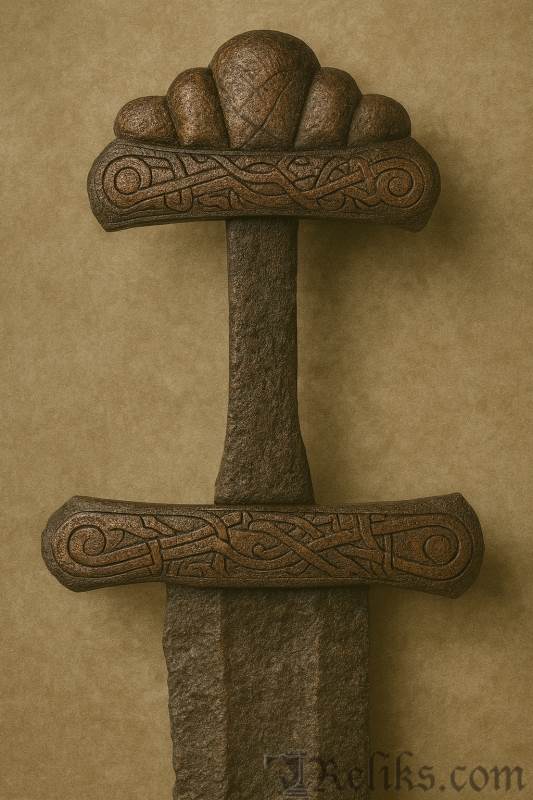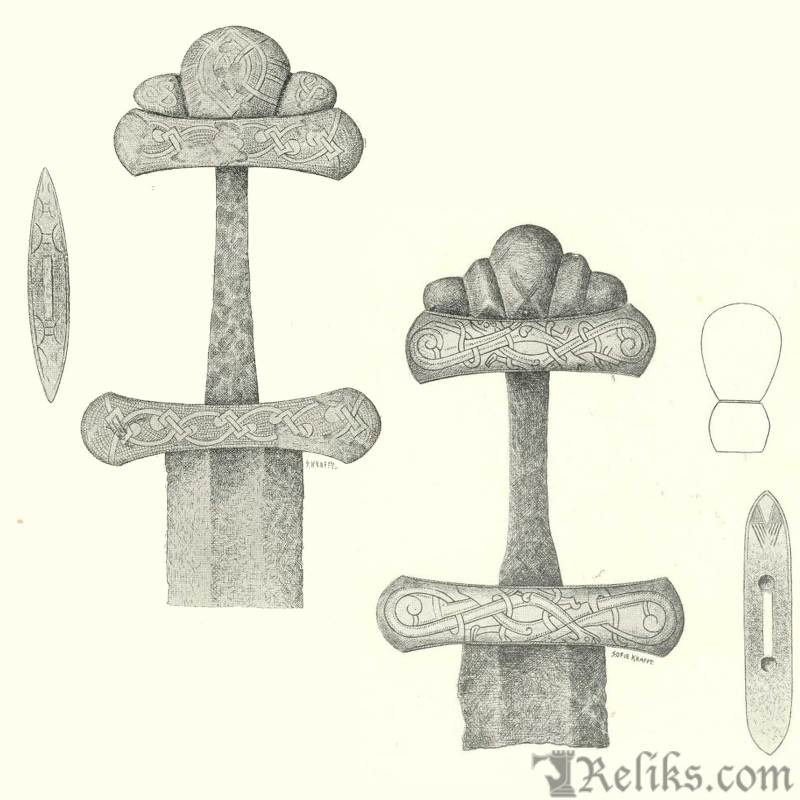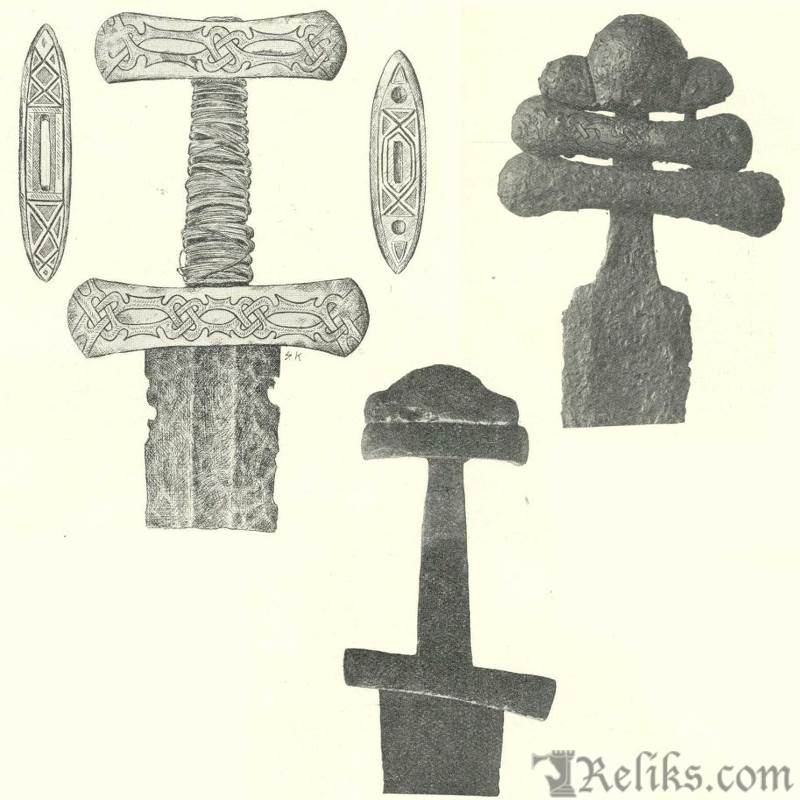Viking Sword Type S (10th century)
Overview
Type S sits in clear kinship with Type R, but everything about it feels more monumental. Where R has a thickened center panel to the pommel, S amplifies that feature into a deep, almost globular mid-section flanked by lower side lobes. The guards are straight in profile yet expanded at both ends (upward and downward), and their convex—never ridged—faces give the hilt a solid, weighty presence. In hand, S recalls the big showpieces of early 9th-century fashion (Types D and E), but it belongs firmly to the 10th century.
Form & construction

Viking Sword Type S (10th century)
The pommel is tripartite, dominated by the swollen center. On several pieces, shallow grooves or a ledge subdivide this center, so at a glance the pommel can look five-part. Heights make the point: Norwegian R-type pommels typically reach ~2.2–2.4 cm, while Type S can rise to ~4.5 cm—right back into the silhouette language of the earliest Viking swords.
Guards are broad and straight with end-flares above and below. Hilt faces are domed (hvælvede) rather than flat or ridged. The “true” S-type is consistently clad in metal: silver sheathing (often mixed with copper alloys) on pommel and guards, with refined ornament—not simple stripe work but plaited bands and, in standout cases, zoomorphic interlace. It’s common to see the underside of the upper guard and the top of the lower guard finished with matching silver inlay panels.
Blades are double-edged. Three Norwegian examples carry the ULFBERHT mark (C 4690 Aaker/Vang; C 571 Nordgården/Sparbu; plus one in Copenhagen with Norwegian provenance). True pattern-welding isn’t attested on this type despite the high status of the fittings.
Distribution & variants

Petersen (fig.114-115)
Petersen records 22 “full” S-type hilts in Norway. The geographic picture is striking: the type clusters on the Østland (Hedmark, Gudbrandsdalen) and Trøndelag, with a few into Romsdal—and is essentially absent on the Westland core (Sunnmøre, the Bergen districts, Stavanger). That contrasts neatly with Type R, which is well represented around Bergen.
Two outliers—Lundskin (T 572, Verdalen, N-Trøndelag) and Villa (T 4331, Vestnes, Romsdal)—lack the metal sheathing. They read as local, simplified imitations of S. One even fastens its hollow pommel in an unusual way: two thin rectangular plates rise from the upper guard into the pommel shell and are then clinched—an inventive workaround to mimic an imported look. Another nice flourish in the corpus is silver wire wound around the tang (C 22138a Vesterhaug/Løten), a detail otherwise mostly seen on late types.
Finds in context & dating
Associated weapons anchor Type S squarely in the 10th century, beginning early and with some pieces drifting later:
- Spears: D-type appears (early 10th); I-type (including transitional/broad forms) and slender K-type with high ridges occur too—pointing into the mid-century and beyond.
- Axes: Mostly K-type variants, with L-type in two finds and even M-type in one (a nudge toward the later 10th).
- Shield bosses: Generally low forms; R 565 turns up in one or two finds—again a younger signal.
- Horse gear & rattles: “Younger” rattles and late stirrups appear in several contexts.
A few specific notes sharpen the timeline. The Sparbu (C 571) Ulfberht sits with an I-type spear, a classic sign of early 10th-century usage. Conversely, Vesterhaug/Løten (C 22138a) shows a narrow fuller that stops short of the point—a blade habit that tends to late 10th trends. The weight of evidence places Type S from the opening decades of the 900s through the mid-century, with select pieces extending into the latter half (and a whiff of the 11th where M-type axes, faceted spear-sockets, and narrow fullers converge).
Origins & style

Petersen (fig.116-118)
Type S is not a homegrown invention. The ULFBERHT blades point up the Rhine, and the plaited silver bandwork on several hilts echoes Carolingian manuscript and metalwork vocabulary. Yet this continental backbone shares the stage with Scandinavian animal ornament—for example, the Sandbu (Va°gå) hilt’s interlace fits comfortably within the Jellinge-style playbook. In other words, S is a hybrid prestige form: continental technique and import blades, filtered through Nordic taste.
The type is also well known beyond Norway—in Denmark (multiple Sjælland and Jutland finds, including a bone-mounted variant), Sweden (Uppland), the Baltic and Russia (Livonia; Küstrin/Custrin), England (a Thames piece with silver tang-wrapping and animal-head hints), and Iceland, where it accompanies K-type spear and axe—again confirming a post-900 horizon.
Closing Reflection
Type S is more than just another entry in Petersen’s typology—it is a statement piece of the 10th century. These swords stand out for their monumentality, returning to the grand proportions of the early Viking Age but clothing them in silver sheaths, plaited bands, and imported Ulfberht blades. They mark a moment when prestige weaponry was no longer experimental but fully consolidated: a warrior’s sword was expected to be both a deadly tool and a glittering symbol of authority.
What makes Type S especially significant is the tension between elite imports and local creativity. In the hands of wealthy landholders or chieftains, we find the full continental package—Frankish blades, silver inlay, and ornament that speaks the same visual language as Carolingian manuscripts. But alongside them appear local “folk versions”: iron-only guards, inventive fastening methods, and simplified forms that prove how deeply these prestige styles penetrated Viking society. Even those without the means to acquire an Ulfberht still wanted a sword that looked the part.
Seen across Norway, Denmark, Sweden, the Baltic, England, and even Iceland, the S-type reminds us that Viking Age Scandinavia was never isolated. Its warriors were plugged into networks of trade, plunder, and gift-giving that spanned from the Rhine to the North Atlantic. To carry a Type S was to embody both Scandinavian identity and continental connection—a hybrid that spoke to ambition, wealth, and status.
For modern readers and collectors, these swords offer a window into a world where weaponry doubled as art, where silver glimmered alongside steel, and where the very shape of a hilt told stories of raids, alliances, and cultural fusion. Type S matters because it shows us how Vikings of the 10th century defined power—not only on the battlefield, but in the glittering language of craftsmanship.
Core classification based on Jan Petersen, De Norske Vikingesverd (1919). Additional commentary by Reliks.com.